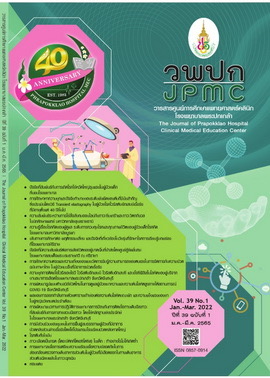Factors Associated with the Mortality Rate in Trauma Patients in the Luntom EMS Center, Queen Savang Vadhana Memorial Hospital
Main Article Content
Abstract
BACKGROUND: Death from injuries is a major problem in Thailand; consequently, an emergency medical service system in the country has been developed. As a result, appropriate and expeditious initial treatment to injured patients at the scene of an accident would reduce the mortality rate.
OBJECTIVES: This study aimed to assess the mortality rate and significant predictors of the mortality rate in trauma patients in the Luntom EMS Center, Queen Savang Vadhana Memorial Hospital, Chon Buri Province, Thailand at discharge time.
METHODS: A retrospective cohort study was conducted between October 1, 2018 and September 30, 2020. The collected data were statistically assessed with multivariable logistic regression analysis.
RESULTS: The sample comprised a total of 152 trauma patients consisting of 75.8% males with a mean age of 39.1 years old. The morality rate counted from the discharge time was 45.5%, and the factors associated with the overall hospital mortality rate were Glasgow Coma Scale (GCS), Injury Severity Score (ISS) and respiratory rate. This result could explain a 56.1% prediction of in-hospital mortality. The equation was able to predict hospital mortality with an accuracy of 89.4% and area under curve (AUC) of 0.946 (95%CI: 0.907–0.985).
CONCLUSIONS: GCS, ISS and respiratory rate were able to accurately predict the likelihood of death relative to previous studies. Furthermore, GCS and respiratory rate were the factors that could be easily and quickly assessed. As such, these factors could improve the appropriate decision-making for prehospital treatment and transportation to the definitive care hospital.
Thaiclinicaltrials.org number, TCTR 20211214001
Article Details

This work is licensed under a Creative Commons Attribution-NonCommercial-NoDerivatives 4.0 International License.
References
Ministry of Public Health. Public health statistics A.D.2018. Nonthaburi: Strategy and Planning Division, 2017.
Siritongtaworn P, Opasanon S. The use of trauma score-injury severity score (TRISS) at Siriraj Hospital: how accurate is it?. J Med Assoc Thai 2009;92:1016–21.
Kuo S, Kuo PJ, Chen YC, Chien PC, Hsieh HY, Hsieh CH. Comparison of the new exponential injury severity score with the injury severity score and the new injury severity score in trauma patients: a cross-sectional study. PloS one [Internet]. 2017[cited 2021 May 5];12(11): e0187871. Available form: https://journals.plos.org/plosone/article/file?id=10.1371/journal.pone.0187871&type=printable
Celso B, Tepas J, Langland-Orban B, Pracht E, Papa L, Lottenberg L, et al. A systematic review and meta-analysis comparing outcome of severely injured patients treated in trauma centers following the establishment of trauma systems. J Trauma 2006;60:371-8.
Emircan S, Ozgüç H, Akköse Aydın S, Ozdemir F, Köksal O, Bulut M. Factors affecting mortality in patients with thorax trauma. Ulus Travma Acil Cerrahi Derg 2011;17:329-33.
Alvarez BD, Razente DM, Lacerda DA, Lother NS, VON-Bahten LC, Stahlschmidt CM. Analysis of the revised trauma score (RTS) in 200 victims of different trauma mechanisms. Rev Col Bras Cir 2016;43:334-40.
Elgin LB, Appel SJ, Grisham D, Dunlap S. Comparisons of trauma outcomes and injury severity score. J Trauma Nurs 2019;26:199-207.
Curtis KA, Mitchell RJ, Chong SS, Balogh ZJ, Reed DJ, Clark PT, et al. Injury trends and mortality in adult patients with major trauma in New South Wales. Med J Aust 2012;197:233–7.
Yadollahi M, Kashkooe A, Rezaiee R, Jamali K, Niakan MH. A comparative study of injury severity scales as predictors of mortality in trauma patients: which scale is the best? Bull Emerg Trauma 2020;8:27–33.

